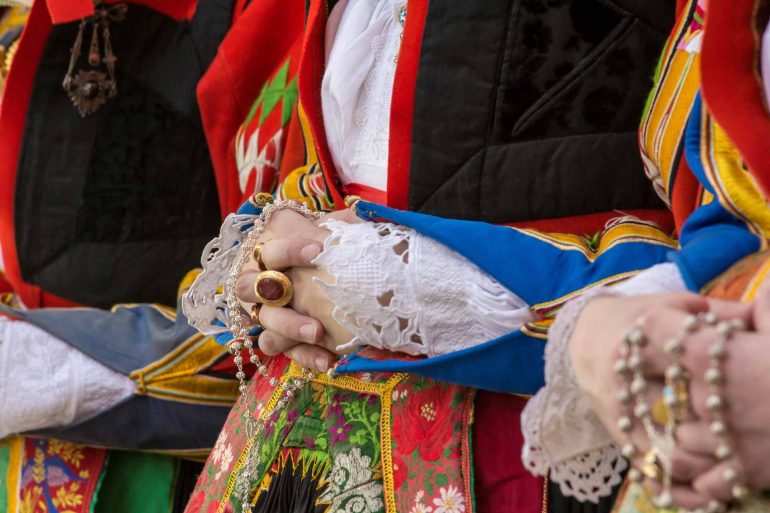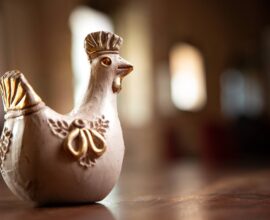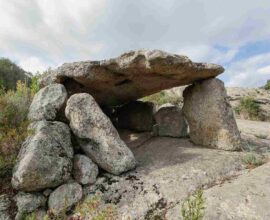Sant’Efisio’s Festival in Sardinia: symbols and rituals between folklore and devotion
Sant’Efisio’s is one of the most important religious festivals in Sardinia
The ancient festival of Sant’Efisio takes place every year in Cagliari, from the 1st to the 4th of May, in a triumph of colours, traditional clothes and devotional songs.
The biggest Festival in Sardinia, Sant’Efisio’s, is a ritual that has been handed down for almost four centuries, a suggestive procession (among the longest and oldest in the world) of 65 kilometres that conquers anyone who has the opportunity to attend, both tourists and Sardinians from all over the island.
From the 1st to the 4th of May, the city of Cagliari is transformed and cloaked in a magical and touching atmosphere shaped by the sound of horses’ hooves and cartwheels and the steps of 3000 people who give life to a solemn procession that winds through the city. Clothed in traditional garments in a triumph of colours and costumes they move to the sound of launeddas (ancient musical instruments that create polyphony) and de is goccius, devotional songs.
Sant’Efisio’s festival, in the name of folklore, history, faith and tradition, has its origins in 1652 when, on July 11, the Municipality of Cagliari addressed its prayers to the Holy Martyr so that, by way of his intercession, he ended the terrible plague epidemic that had spread on the island. If this had happened, Cagliari would have paid homage to him over the centuries, every year, with a solemn rite.
In September 1656, the epidemic began to slow down until it disappeared completely and, thus from the following May, the community always respected the promise, with gratitude and devotion, even under the bombings of 1943 and the recent Covid 19 pandemic.
It is a unique moment for the capital and the whole island, an unmissable event for devotees of the Saint but also for anyone who is visiting Cagliari in the four days of the party. This is a wonderful opportunity to take memorable photographs and savour all the charm of moving rituals.
A majestic procession that touches the soul
To honour the saint who promised to protect Cagliari and its inhabitants forever, the majestic procession begins at noon from the picturesque streets of the Stampace district. Stampace is one of the four historic districts of the city and it was built in the thirteenth century at the foot of the mighty walls of the Castle.
In front of Palazzo Civico, in the embrace of the bells that ring in celebration and the echo of the sirens of the ships, Efisio pauses to receive the tribute of the citizens in what can be defined as the most exciting moment, of profound participation.
To make everything even more enchanting, the ritual known as sa ramadura, the shedding of pink, yellow and red flowers and perfumed essences to create a path for the chariot carrying the simulacrum of Sant’Efisio to advance on a colourful floral carpet, in a journey between faith, authenticity and the millenary culture of the Sardinian people.
Along the way, after the passage of over two hundred knights, the Militiamen, the Campidanesi and the Guardiania, and the expectation of the Saint, poignant devotional songs spread in the air intoned by the voices of four cuncordu formations.
The whole city is immersed in an atmosphere of true celebration while the procession goes on with floats adorned with flowers and fruit, the sumptuous traccas, and the chariot pulled by a pair of horned oxen adorned with wreaths of flowers while the brotherhoods delight those present with their songs.
The procession then starts towards Nora, the place of the martyrdom of Sant’Efisio, passing through the churches of Giorgino and Su Loi (Capoterra), Villa d’Orri, Sarroch, Villa San Pietro and Pula.
Reaching the beach of Nora, the simulacrum of the Saint is exposed to the faithful at the Romanesque church named after him and then resumes the journey of return on the evening of May 4th with an engaging night procession on the notes of the songs of devotion.
The return to Stampace takes place in the presence, once again, of thousands of faithful who, at the end of the celebration, greet each other with the wish “a atrus annus! “.
Four intense days that see a preparation that lasts a whole year.
In every village, care is dedicated to the precious folk clothes that are handed down from generation to generation. The sisters of the Gonfalone wear a black dress with a veil on their heads while the confreres in penitential dress, with a blue suit.
The Alter Nos, which represent the Municipality, accompany the Saint riding in a top hat and tailcoat.
Would you like to attend the majestic Festival of Sant’Efisio and experience a fabulous holiday in an authentic paradise? Discover Forte Village Resort in Sardinia






